What Comes Back
A “Cliff Notes” Story
November 2012
There is no record of another Atlantic storm like Sandy. We’ve seen storms that brought more rain or more wind — though Sandy still brought wind enough to leave millions without power, without light or heat as November began. But it was mainly with its storm surge that Sandy brought so much misery to so many. The gigantic storm — almost a thousand miles across! — made landfall on Monday evening, October 29, the very day of the full moon, when high tides run higher than normal. Within an hour or two the flood waters had wrecked miles upon miles of beloved Jersey shore, thousands of homes and dreams. Subway stations and tunnels went under on lower Manhattan, as well, while in Bergen County the Hackensack River overtopped a berm and poured into neat little neighborhoods in Moonachie and Little Ferry; days later, the sidewalks remained choked with the waterlogged stuff of lifetimes. (Yet luckier, perhaps, than those neighborhoods on Staten Island where flood waters rose so fast that some drowned in their homes.)
It’s been decades since anyone has lived along the twelve miles of Hudson River shore in our park. We can tell only of ruined property, not ruined lives: twisted walkways and wrecked boat houses in boat basins; flooded restrooms and storerooms, their locked doors battered down by the rising tide; big parapet stones rolled into the river, piles of debris threaded across parking areas and playgrounds like snow drifts of river trash; and one shattered historic house.
We had canceled our annual “Hallowe’en Hike” scheduled for Sunday evening and spent a couple of hours at the Kearney House that afternoon, the day before the storm, moving things up. Floor cloths up off the floors, chairs and baskets up the stairs, the big stuff up on benches. We had gotten sixteen inches of water in the house during Irene, last year, almost two feet in 1991’s “Perfect Storm.” We planned for three feet this time, figuring it would be less. But better to be safe.
One last look at the place before we took ourselves back up the mountain, one “Good luck little house” spoken out loud.
Strange wishing this particular little house luck, though. This little house whose stone walls — a foot and a half thick — have withstood two and a half centuries of storms and floods (and, according to some stories, even a cannonball or two). Never mind the elements — this little house has withstood a few generations of children growing up in it, too! Then, when it was Mrs. Kearney’s tavern, a hundred and fifty years ago, it was nightly filled with rough-and-tumble rivermen. Thereafter it was left abandoned more than once, camped in by shad fishermen now and then, until in the twentieth century it became a park police station for a while, then a “historic shrine,” then more or less abandoned again. Fixed up at the close of that century, it’s lately been a “living history museum,” its hearth brought back to life, a couple thousand visitors stepping through its Dutch doors each year.
One more storm.
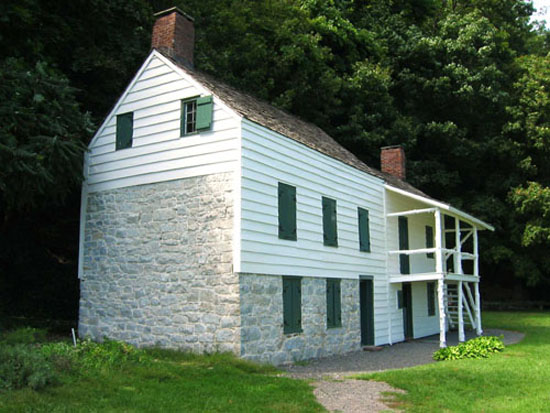
No one was there when the front stone wall collapsed. We think it was the combination of wind-blown waves beating on it, coming relentlessly on more than four feet of rising water, and the water itself, pushing its way through the two windows in the stone wall — the vulnerable spot, the height never reached by flood waters before — pushing between the stones, washing into the centuries-old, dried mud between them.
After the wall collapsed, all that we had left carefully stacked downstairs was toppled, spilled, scattered. The wooden front wall on the northern, circa 1840 addition — the “tavern room” — broke free and pulled away from the floor as the flood waters finally retreated, what they left behind now coated in oily mud.
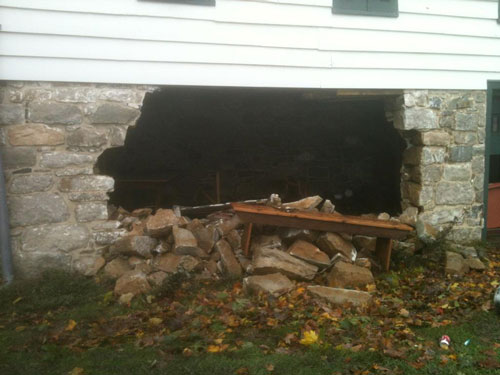
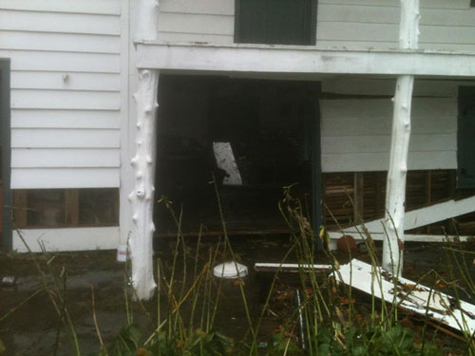
Throughout, the second floor and attic stayed bone dry, all the stuff we’d brought up there standing where we left it. In the bedroom the clock ticked on the mantel, chiming every half hour.
By Wednesday morning — Halloween — the park maintenance department was on it, gathering and piling the pieces of the broken wall (to be used to rebuild), helping us separate artifacts from mud and debris. The amazing carpenters of the dock crew — the guys who keep the century-old wooden boat basin up and running — built some temporary framing to stabilize the structure, to take the weight off the three surviving walls. They did the same in the tavern room. They had to remove the broken wall, leaving the front of the house gaping open, looking as if, as one volunteer said through some tears that morning, its front teeth had been knocked out. But it was standing; it had faced down the worst storm of its long years.
While all this was going on, we washed mud off plates and bowls and candlesticks and everything else, as best we could, using cold water from a garden hose. By Saturday the dock crew had erected temporary plywood walls to protect the house from the elements, from the curious.
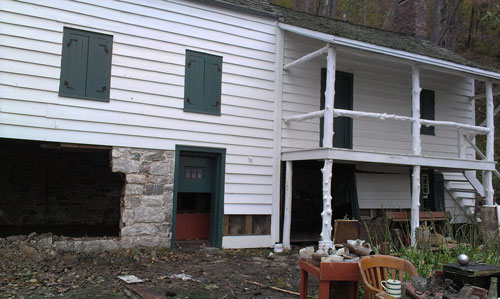
Day after day, meanwhile, the maintenance department and the trail crew worked away at the big debris field that had collected between the house and the pavilion. It seemed the storm water had created a kind of eddy there, at the base of the Closter Dock Trail. Branches, leaves, trash, a dead raccoon, pieces of the boat basin, of boats, all had collected in a soggy mass that was loaded into the bucket of a front-end loader again and again as it made countless trips to dumpsters that were dropped off, filled, hauled away again, replaced. As they picked through the endless debris, the workers kept finding things that belonged to the house.
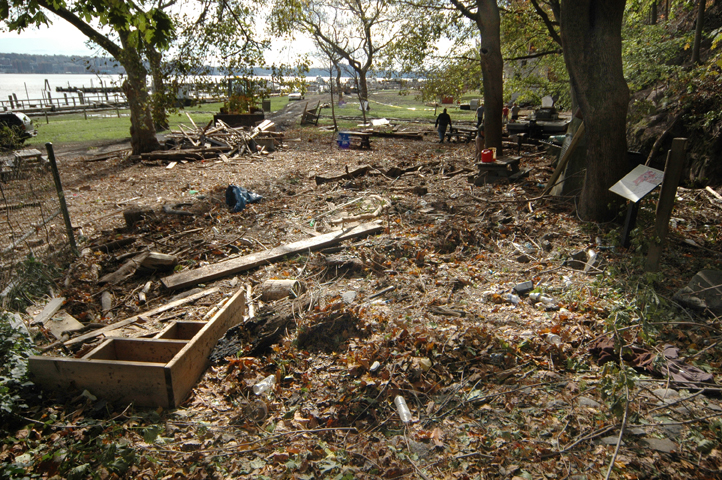
Strange what comes back, what doesn’t. Stacks of light wooden bowls, still nested together, have come back; a pair of heavy wooden wash basins — gone with the tide. A heavy, ancient iron kettle was pulled unharmed from mud and crumbled stone; its little iron lid — who knows? A big yellow tool box comes back; two or three loose hammers don’t.
Strangest of all may be Alexander. He was part of a driftwood carving one of our visitors had given us some years ago, a little Santa-like figure that had been attached to a driftwood root wrapped around a rock. It always struck us as something a riverman might have whittled as he whiled away a few hours waiting on the tide, and so we kept it on the table in the tavern room. Several days into clearing the debris field, one of the trail crew found him, broken off from the root and rock but otherwise intact. (We hadn’t named him before he came back. We chose “Alexander” after Alexander Campbell, one of the leaders of the little community at Closter Landing in Mrs. Kearney’s day, a dock builder and sloop captain — and also a skilled wood carver, some of whose work survives today. Among those who knew him, Alexander Campbell went by “Sandy.”)

A week after that unbelievable high tide we lit a fire in the hearth of our shattered historic house for the first time since the storm, heated some water in our old iron kettle — we used the lid from a missing aluminum coffee pot to cover it — and started to wash our dishes properly. It will be months before we’ve brought the house back to something like it was, before Sandy hit. But for a little bit it was encouraging to smell the fireplace burning again, to feel its warmth. Some things may be meant to come back.
– Eric Nelsen –

